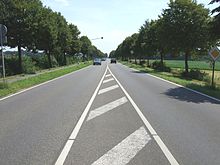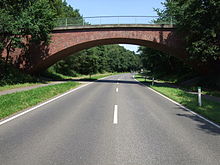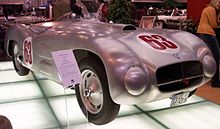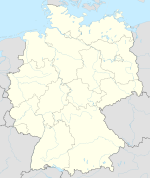Grenzlandring
|
|
|
|
|
|
||
| Route type: | temporary racetrack | |
|---|---|---|
| Opening: | September 19, 1948 | |
| Decommissioned: | 1952 | |
| Track layout | ||
| Route data | ||
| Route length: | 9.005 km (5.6 mi ) | |
| Records | ||
| Track record: (automobile) |
2:33 min. ( Toni Ulmen , Veritas RS, 1951) |
|
| Track record: (motorcycle) |
2:30 min. ( Schorsch Meier , BMW, 1949) |
|
Coordinates: 51 ° 8 ′ 20 ″ N , 6 ° 17 ′ 18 ″ E
The Grenzlandring , more rarely also Grenzland-Ring ; abroad to his racing time as Wegbergring respectively Wegberg- ring known is an original 9005-meter long and 6.8 meter wide ring road which before the Second World War at the left Lower Rhine as a military supply and transport road around the town Wegberg in Monchengladbach was built . On it pear on aerial photographs or maps or ovate presenting concrete - oval course with banked curves minimal few years found after the war in front of up to 300,000 spectators a total of five large auto and motorcycle races held. At that time, the high-speed railroad was often referred to in the media as "the fastest racetrack in the world" before one of the most serious accidents in international racing history abruptly ended its use in motorsport on August 31, 1952.
The construction


In 1938 or 1939, the construction of the Ringstrasse was completed as a “strategically important parade route for the Western campaign ”. The bypass of Wegberg and Beeck near the border with the Netherlands was completed at a cost of around 3.3 million Reichsmarks . The " Iron Rhine " railway line running through Wegberg was crossed by two bridges . The road was planned as a supply and connection route between the construction sites for the West Wall systems . However, due to its insignificant use during World War II, it was soon forgotten.
According to more recent findings, the Grenzlandring was built on behalf of the Wehrmacht by the Cologne-based construction company August Lindemann, who specializes in the construction of concrete roads - and not, as one might have expected, by the Todt organization , which was responsible for such large-scale projects during the National Socialist era was responsible. In the first phase of planning, it was assumed that there were two independent bypass roads - one in the south and one in the north - which were supposed to relieve the narrow streets of Wegberg and Beeck from the rapidly increasing traffic on the Westwall, until the regional planners of the Rhineland regional planning association for the Aachen district office decided on one Insert ring shape. The rumors, which are not absurd, persist to this day that the motor school of the National Socialist Motor Vehicle Corps (NSKK) , which was stationed in Rheindahlen at that time, exercised influence in order to secure the possibility of a suitable test, demonstration, teaching and exercise route, such as it existed before in Teterow with the Teterower Bergring and Hohenstein-Ernstthal with the Sachsenring . The residents were forced to surrender the land required for construction for a relatively small fee. While the construction costs were estimated at around 2.8 million Reichsmarks, a good 500,000 Reichsmarks were taken into account for the purchase of the land. After that, the ring is said to have been built in around 434,300 working hours.
The alleged discovery of the Grenzlandring


According to oral reports from contemporary witnesses and press reports, the Grenzlandring, which remained almost undamaged during the war , was discovered by chance during a business trip by the then Lord Mayor of Rheydt , Carl Marcus, on one night in 1947 . After he had passed the same cyclist several times on a normal-looking country road, he only realized that he had to be on a ring road. Since it was planned as a military facility and built practically in camera, its existence is said to have remained largely unknown even in this border region . In addition, it was not shown on the maps available at the time . This story is more likely to be a clever marketing gag of the protagonists of the time than facts. Against them speak among other reports that the ring could be driven not continuously from spring 1945 to 1948 in because he by US troops in the area of Rheydter line was used as a fuel depot and the British occupiers in the Erkelenzer straight one Operated workshop for military vehicles. Nevertheless, the alleged discovery by Carl Marcus, who occurred in the time of National Socialism a . a. worked as a double agent for both the German and the British side and was appointed by the British as Mayor of Rheydter between 1945 and 1948, since then inextricably linked with the racing history of the Grenzlandring.
According to tradition, Marcus reported soon after the Rheydter silk manufacturer (owner / manager of the silk weaving C. C. Bang) and Gentleman - racer Emil "Teddy" Vorster of his "discovery". The chairman of the Rheydter Club for Motorsport (RCM) checked the ring, located just a few kilometers from his front door, for possible racing suitability. In March 1948, after a meeting of the German Motor Club (DMC) in Cologne , Vorster brought some active driver colleagues and officials such as Hermann Lang and Alfred Neubauer to Wegberg to hear their verdict. After the demonstration rounds on the ring, the experts involved quickly came to an agreement on site and then informed the press: “The Grenzlandring replaces the AVUS and Tripoli for us (meaning the pre-war Libyan racetrack Autodromo della Mellaha , located between Tripoli and Tajura ). In addition to the incomparable Nürburgring as a mountain track, it is indispensable as an incredibly fast flat race track for the major tests for machines and drivers, which the German automotive industry, if it is able to enter the comprehensive competition in all markets of the world again, cannot do without. "
The racing years 1948 to 1952
Initiated by Teddy Vorster and his RCM and organized in cooperation with the Erkelenz Motorsport Club, the first race took place on September 19, 1948 after both clubs had repaired the damage to the track that had occurred during the war at their own expense as part of a joint venture. The then Prime Minister of North Rhine-Westphalia , Karl Arnold , ceremoniously put "the Grenzlandring - the AVUS des Westens" into operation. Around 250,000 spectators were enthusiastic, more than 100,000 people had not been expected before, and according to contemporary witnesses, “the whole entrance fee of the countless people was taken away with buckets and wheelbarrows”. In the inevitable organizational chaos, a considerable part of the income on the way from the town hall in Wegberg to the bank in Rheydt is said to have disappeared without a trace. In any case, the sums counted here and there did not coincide in the end, a leading member of the organizing committee later reported. The driving force of the entire Grenzlandring project, Teddy Vorster, took part in the race of vehicles up to 1100 cm³ with his AFM sports car and defeated his conqueror at the German championship in 1948, Petermax Müller .
On April 24, 1949 the Rheydter Club für Motorsport, the Motorsportclub Grenzlandring Wegberg, the Automobil- und Motorclub Krefeld and the Gladbacher Motor Club Mönchengladbach established the so-called Motorunion Grenzlandring e. V. with headquarters in Wegberg, under whose care the other four races were then carried out.
At the end of the 1940s and early 1950s, the Grenzlandring, which, with the exception of the 1949 races, which were attempted clockwise, was always driven counter-clockwise , was considered in some German media - albeit not according to the facts - as the “Fastest race track in the world”, but sometimes only the “fastest flat race track in Europe” was mentioned, on which top speeds of up to 250 km / h were achieved. Strictly speaking, there were only two straights of different lengths - the Rheydter Straight with 2322 meters and its crest over a railway underpass, which has parallels to the original "Mulsanne" of Le Mans , and the Erkelenz Straight with 2052 meters - as well as two unevenly curved bends - the Roermond curve at 3327 meters and the Gladbacher curve , also known as the Beecker curve , at 1304 meters. The absolute lap record set in September 1949, the then already legendary "Cast iron Schorsch" Meier (u a total winner.. Tourist Trophy of 1939 on the Isle of Man from Bavaria with its) motorcycle , a BMW - compressor with 500 cc engine capacity , and drove it an average of 216 km / h clockwise. The Grenzlandring lap record for automobiles went to Düsseldorf's Toni Ulmen two years later when he reached a counter-clockwise average of 212 km / h in his Veritas RS in September 1951 . And almost all of the racing greats of that time met at the annual race in Wegberg: Karl Kling , Hans Stuck , Fritz Riess , Huschke von Hanstein , the Belgian André Pilette , the Italian Gianfranco Comotti , the British Stirling Moss , etc. with theirs Cars as well as Wilhelm Herz , Ludwig "Wiggerl" Kraus , Heiner Fleischmann , H. P. Müller , Walter Zeller u. a. on their motorcycles. Their biggest problem was almost always the available tires - "often at the maximum speeds achieved, the rubber pad was simply torn from the canvas by the rough concrete", reported course record holder Schorsch Meier about 25 years later in an interview.
Accidents

The first racing accident on the Grenzlandring occurred on September 17, 1950 as part of the Formula 2 round of the third race. Shortly before the end, the Remscheid-based manufacturer and racing driver Karl Gommann skidded with his AFM during an overtaking maneuver in the Gladbach bend on a wet track and suffered fatal head injuries in a subsequent rollover.
On Sunday, August 31, 1952, one of the most serious accidents in international motorsport history happened in the afternoon, with at least 13 fatalities - according to some sources there is said to have been a fourteenth unknown death - and 42 injured. The exact time of the accident is disputed; while in later newspaper reports mostly of "approx. 5:00 p.m. ”, according to the program, the start of the unlucky race had already been scheduled for 2:50 p.m., which makes around 3 p.m. appear more credible as the time of the accident. The Berlin racing driver Helmut Niedermayr , lying in fourth place shortly before the end of the first lap of the Formula 2 race, drove off the track with his Reif Veritas Meteor two-seater at a speed of almost 200 km / h for unexplained reasons . The accident occurred on the exit of the Roermond curve , around 250 meters behind the stone bridge to Wegberger Friedhof, at the level of the exit to Klinkum at the time. The racing car drove into the crowded, unprotected spectators in the inner area of the curve, which until then had been considered harmless. Crash barriers, safety fences, gravel beds and the like were not common back then - some randomly distributed straw bales and several wire ropes stretched between wooden posts were the only "safety precautions" along the way. According to eyewitness reports, the very wire ropes behind which the audience should stand caused the worst injuries. Dragged along by the racing car, they are said to have severed body parts of the victims and caused severe head injuries, especially in the affected children. Niedermayr himself, despite numerous facial injuries, is one of the slightly injured, reportedly only received medical care after the helpers had previously looked after several other injured people.
Despite the accident, the race was not canceled and Toni Ulmen won. According to later statements by the race management, this ad hoc decision was made in consultation with the leading politicians present, including Federal Transport Minister Hans-Christoph Seebohm and the North Rhine-Westphalian State Minister for Economics and Transport Artur Sträter , the ADAC sports president Jules Köther and the racing doctors on duty, taken so as not to cause panic among the crowds, chaos or handicaps caused by onlookers. Shortly after the event, the then North Rhine-Westphalian interior minister then closed the Grenzlandring for all other racing activities. After that, the Grenzlandring was never used again for motorsport of any kind and its sporting history was largely forgotten even by the residents.
In the years that followed, safety standard regulations were drawn up for all motorsport racetracks in Germany that racing had to comply with from then on. An additional problem for those directly affected by the disaster later turned out to be that the survivors of the victims and the surviving injured were only compensated with extremely low compensation payments from the organizers, their insurance companies and the responsible authorities. Some procedures dragged on for years and were still unsuccessful.
The cause of the accident
According to reports, the exact cause of the accident could never be determined. Even Helmut Niedermayr himself was no longer able to provide plausible explanations after his shock. The press almost exclusively speculated about a technical defect in the vehicle, but there was also talk of an offset or an edge at one point of the concrete pavement that threw the car out of its lane. In 1992, the eyewitness Herbert Meyer from Klinkum took the view that the accident was caused by a driving error by Niedermayr and provided a drawing of the course of the accident. According to him, Niedermayr tried to overtake one or more of three racing cars in front of him, driving very close to the right outer edge. He is said to have overestimated the width of the lane in the area of the exit to Klinkum and touched one of the bales of straw that had been placed there to mark the route with his car. As a result, he finally lost control of his car and shot to the left across the racetrack into the spectator area. A photo in the holdings of the Mönchengladbach city archive, which shows the Niedermayr meteor just drifting away, underpins at least part of Meyer's statement.
Todays situation
In the area of the accident site, the ring was separated later, at the exit on Klinkum the main road 367 in the direction Wassenberg and Roermond in right angles to have branched off from the ring road. The original course of the road was abandoned, but it can still be recognized as an approximately one hundred meter long incision in the terrain. In addition, today there is a memorial stone at the site of the accident in memory of the 13 certified fatalities.
The standing world records
In 1950, a total of four cycling world records were set on the Grenzlandring. After the French stayer - cyclist and journalist José Meiffret already on 7 February with his special racing of a motorcyclist and behind a cable attached to the machine wind shield to a speed of 104.880 km / h had "pull" stated Karl-Heinz Kramer three more world records a few months later. On June 28, Kramer drove 105.859 km / h and on October 12, 1950 first 139.500 km / h. On the same day, he set the still valid world record for a standing cyclist behind a motorcyclist as a so-called pacemaker . Kramer reached 154.506 km / h on the Grenzlandring and therefore only needed 23.30 seconds for the 1 km distance. The absolute highest cycling speed was achieved on October 3, 1995 by the Dutchman Fred Rompelberg after driving 268.831 km / h behind a special dragster vehicle with a huge wind hood on the Bonneville Flats in the Great Salt Desert of Utah in the USA . This was broken by Denise Mueller-Korenek on September 16, 2018 at 296.01 km / h, but Fred Rompelberg remains the fastest man.
present

Nowadays, the Grenzlandring, which used to be entirely made of concrete, is completely asphalted and, after various modifications in the entrance areas of the Beecker curve and the Roermond curve , no longer presents itself as a closed ring road, but as a useful bypass road, but at their exits and entrances mostly no right of way applies. About two thirds of its total length is shown on the maps as the current L 400 and one third as L 3. Since even the start-and-finish facilities and spectator stands, which were always placed between the streets to Tüschenbroich and Uevekoven , were only temporary and were set up for the events, there are no more clues to suggest that the Grenzlandring was used for five years of racing to let.
For many years, the city of Wegberg has had a rather distant relationship to the accident on its Grenzlandring, which serious statistics place in fifth place among the most serious accidents in motorsport history by number of fatalities. To mark the 60th anniversary of the accident, a memorial stone was erected on the initiative of the Wegberg Historical Society to commemorate the 13 fatalities documented. This means that the exact scene of the accident is now also marked, which was known only to a few local people.
The Rheydter club Motorsport (RCM) , under Teddy Vorster leadership initiator of all five Grenzlandring race, organized since 1978 as part of the VLN Endurance Championship Nürburgring the Veranstaltergemeinschaft endurance championship Nürburgring (VLN) its annual "Grenzlandrennen" on the Nürburgring , still in line of its Grenzlandring history. The anniversary event on August 18, 2007 was the 30th RCM- DMV border race.
The most important automobile winners of the five Grenzlandring races
| meeting | Results | |
|---|---|---|
| September 19, 1948 (National Race) |
Formula 2 and Formula Libre :
|
Formula 3 :
|
| September 11, 1949 (National Race) |
Formula 2 and Formula Libre :
|
Formula 3:
|
| September 17, 1950 (National Race) |
Formula 2:
|
Formula 3: |
| September 9, 1951 (International Race) |
Formula 2:
|
Formula 3:
|
| August 31, 1952 (International Race) |
Formula 2:
|
Formula 3:
|
The most important motorcycle winners of the five Grenzlandring races
| meeting | Results | |
|---|---|---|
| September 19, 1948 (National Race) |
Licensed drivers in the class up to 500 cc:
|
Licensed drivers in the class up to 350 cm³ displacement:
|
| September 11, 1949 (National Race) |
Licensed drivers in the class up to 500 cc:
|
Licensed drivers in the class up to 350 cm³ displacement:
|
| September 17, 1950 (National Race) |
Licensed drivers in the class up to 500 cc:
|
Licensed drivers in the class up to 350 cm³ displacement:
|
| September 9, 1951 (International Race) |
Race in the class up to 500 cm³ displacement:
|
Race of the class up to 350 cm³ displacement:
|
| August 31, 1952 (International Race) |
Race in the class up to 500 cm³ displacement: | Race of the class up to 350 cm³ displacement: |
literature
- Dietmar Schmitz, Folkmar Pietsch; Historical Association Wegberg (ed.): The Grenzlandring - "the Avus" of the West 1948–1952 . ROKA-Verlag, Wegberg 2005, Vol. 4, ISBN 3-926525-52-5 .
- Froitzheim, Achim: The Grenzlandring - The (un) forgotten race track 1948–1952 . Self-published, Wegberg 1992.
- Marco Kieser: The Grenzlandring - A piece of domestic and German motorsport history. In: Heimatkalender des Kreis Heinsberg 2006, Kreismuseum, Heinsberg 2006, pp. 166–186; ISBN 978-3-925620-23-2 .
- Marco Kieser: The Grenzlandring. In: Claudia Euskirchen, Marco Kieser, Angela Pfotenhauer (eds.): Lecture hall, office and market place. Research and preservation of monuments in the Rhineland, commemorative publication for Udo Mainzer for his 60th birthday. Sigurd Greven Studies 6. Schell & Steiner, Regensburg 2005. ISBN 3-7954-1766-X ; Pp. 135–149 (short version)
- Wilhelm Josef Gerhards : What the Niers whispered to us . Stories and anecdotes from old Mönchengladbach, Rheydt and Wickrath. Wartberg, Gudensberg-Gleichen 2008, ISBN 978-3-8313-1927-5 , pp. 30th ff .
Web links
- Motorsport Memorial: Car and truck fatalities by circuit. Ordered by surname (Grenzlandring)
- Short text in English and current Grenzlandring photos
Individual evidence
- ^ To Carl Marcus: Heike Bungert: Review of: Reinhard Doerries (Ed.): Diplomats and Agents. Intelligence Services in the History of German-American History. Heidelberg 2001. In: H-Soz-u-Kult, April 12, 2002.
- ^ Motorsport Memorial - The names of the victims of the fatal racing accidents. motorsportmemorial.org
- ↑ This is no longer available today because it later had to give way to a gravel pit.
- ↑ Grenzlandring: The day of the sacrifice. Der Spiegel , September 10, 1952; Pp. 5-7. (PDF file; 628 kB)
- ↑ A photo taken immediately before the accident on Marco Kieser's Motorsport Stories website .
- ↑ New world record: American cyclist through the desert at 296 km / h . In: Spiegel Online . September 20, 2018 ( spiegel.de [accessed December 15, 2019]).
- ^ Motorsport Memorial: Motorsport most tragic accidents by number of fatalities. motorsportmemorial.org.





